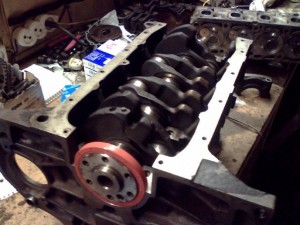How Internal Combustion Engines Work
The internal combustion engine (ICE) continues to power the world over 100 years after it became mainstream. In fact engineers still haven’t found a viable way to better it. Combustion engines comprise a cylinder, within which is housed a piston and connecting rod. The piston is attached to a crank at the bottom, and as it moves up and down in the cylinder, the crank rotates. Importantly, this is how power is transferred to the wheels.
The force driving the piston is created at the top of the cylinder, in the combustion chamber. A combustion engine operates by harnessing the energy of intermittent explosions, lots of them in succession every minute. This converts a tiny drop of fuel into a force that turns the road wheels, driving the car. Most engines run these explosions right on the cusp of them becoming uncontrollable – that’s where maximum power is produced.
Through a series of valves, a fuel and air mix enters this chamber, and is compressed. It is then either ignited (petrol) or spontaneously combusts (diesel); the resultant explosion kicks the piston back down in the cylinder.
Engines are made of several cylinders, whose individual pistons are connected to a common crank. This duplicity means biggest ‘bang for buck’, though car makers must balance fuel usage. More cylinders usually means more fuel used, and the optimum is four cylinders in a line, but they can also form V-arrangements or horizontally opposed layouts.
 Engines are measured by various means – in Europe, litres or cubic centimetres (‘cc’) are familiar, while the United States use cubic inches. All measurements refer to an engine’s displacement: the total volume swept by a piston in a single movement. Often, instead of adding more cylinders, engine power is increased by boosting this swept volume. It’s the difference between a 1.6-litre and a 2.0-litre four-cylinder engine.
Engines are measured by various means – in Europe, litres or cubic centimetres (‘cc’) are familiar, while the United States use cubic inches. All measurements refer to an engine’s displacement: the total volume swept by a piston in a single movement. Often, instead of adding more cylinders, engine power is increased by boosting this swept volume. It’s the difference between a 1.6-litre and a 2.0-litre four-cylinder engine.
Honing a theme with technology
Direct fuel injection is becoming popular- this injects fuel straight into the combustion chamber during the compression stroke. It maximizes the cooling effect of fuel and allows the engine to run a higher compression ratio -economy and power both improve.
Combining direct injection with a turbo is a further efficiency: it combines a turbo’s bang while eliminating its characteristic compression ratio. Some makers even include variable valve timing as well – these super-high tech engines are in showrooms now, proving they can be made for a competitive price.
Further afield are variable displacement engines. In their most basic form, these ‘turn off’ engine cylinders in low-demand situations.
Makers will develop this concept in the future with more intelligent solutions.
Several firms are exploring the DiesOtto concept. This mixes a diesel’s compression ignition in a lean mode, with the spark of a petrol engine when more power is needed – in the same powerplant. Units are already undergoing testing, by firms such as Volkswagen and Mercedes.
Lotus is working on a two-stroke engine called Omnivore. Using charge compression with a moveable section cylinder head, this alters the compression ratio from 10:1 to 40:1. Valves are in the cylinder walls, and fuel is injected direct into the cylinder. It’s called Omnivore because it can use a variety of fuels.
Moving the fire outside the walls
An external combustion engine works through heating up an internal fluid by an external source. Think of a steam train: an open fire heats up fluid through a heat exchanger – the expansion of this fluid drives an engine. This fluid is then cooled back down again, before being reheated and expanded. The principal is why steam trains require lots of water coolant.
More in for more out
 A simple route to more performance is to make the engine capacity bigger. This allows it to burn more fuel. You can do it either by adding more cylinders, or making individual cylinders bigger.
A simple route to more performance is to make the engine capacity bigger. This allows it to burn more fuel. You can do it either by adding more cylinders, or making individual cylinders bigger.
Increasing the compression ratio also produces more power, but this cannot be done limitlessly. More accuracy in injecting fuel also ups efficiency.
Adding a turbo forces more air and fuel into the cylinder, at higher pressure. And with turbo engines, cooling incoming air with an intercooler means greater expansion upon compression.
Perfecting what’s already there also increases performance – polishing inlet and exhaust ports allows air to flow easier, which can give huge gains.
